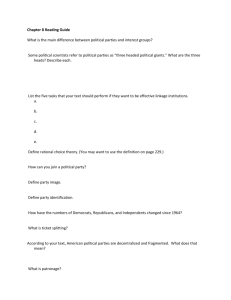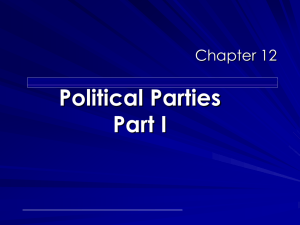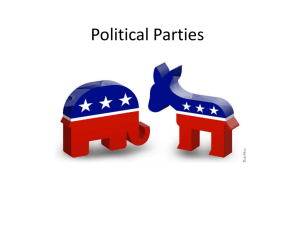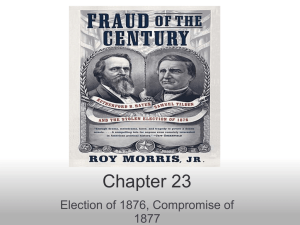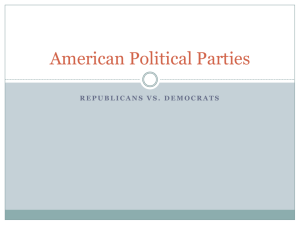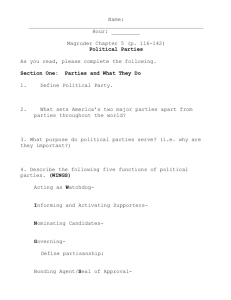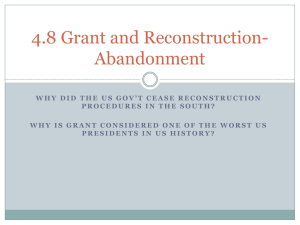Political Parties, Interest Groups, and Mass Media
advertisement
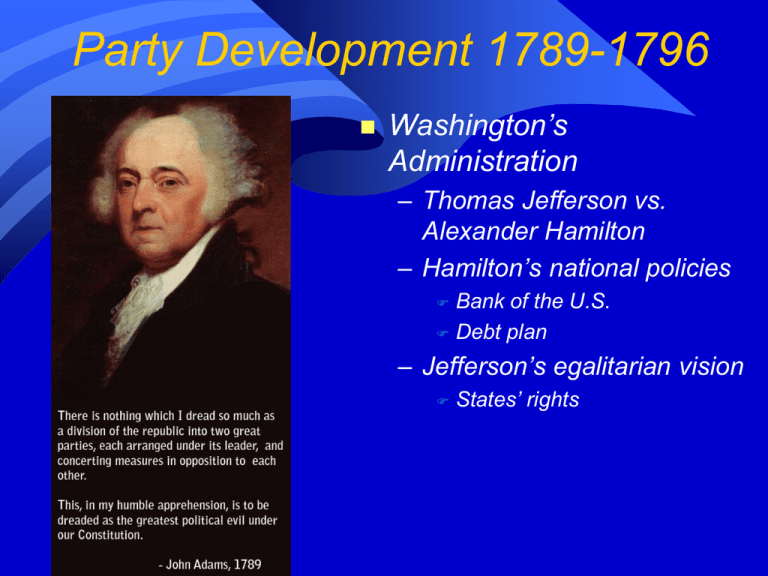
Party Development 1789-1796 Washington’s Administration – Thomas Jefferson vs. Alexander Hamilton – Hamilton’s national policies Bank of the U.S. Debt plan – Jefferson’s egalitarian vision States’ rights Realignment Election of 1800 First Party System (1796-1824) Federalists vs. Democratic-Republicans Revolution of 1800 – Jefferson (D-R) defeats Adams (F) – D-R control Congress – Peaceful transition of power War of 1812 – D-R and War Hawks against Britain – Federalists support Britain, against war – Leads to collapse of Federalists Era of Good Feelings (1816-1824) – Virtual one-party system as D-R dominate White House and Congress Election of 1824 – Factions develop among D-R leading to Corrupt Bargain as John Quincy Adams secures victory over Jackson in House Realignment Election of 1828 Second Party System (1828-1854) Democrats vs. National Republicans/Whigs Andrew Jackson and the Common Man National Conventions replace Caucuses – Anti-Masonic Party introduces national convention in 1831 Whigs – Henry Clay and the American System Democrats – States’ rights and Manifest Destiny – Solid South Slavery – Kansas-Nebraska Act (1854) weakens Whigs and leads to founding of Republican Party Realignment Election of 1860 Third Party System (1860-1896) Democrats vs. Republicans – Government dominated by Republican Party Election of 1860, Civil War, Reconstruction – Lincoln’s election led to Civil War – Democrats lost power with secession of South – Radical Republicans enforced party platforms Freedmen, Scalawags, Carpetbaggers Democrats – Bourbon Democrats - pro-business, laissez-faire – Redeemers - Southern Democrats return to power at end of Reconstruction Republicans – Mugwumps, Stalwarts, Half-Breeds - civil service reform Political Machines and Political Bosses – Tammany Hall and Boss Tweed Populists and Panic of 1893 – Reforms, bimetallism (gold and silver) Election of 1896 – William Jennings Bryan (D) vs. William McKinley (R) Realignment Election of 1896 Fourth Party System (1896-1932) Republicans vs. Democrats Republicans – Party of business and prosperity Democrats – Embraced progressive reforms and more government intervention – Solid South Progressive Era Republican Domination of 1920s – Limited government and pro-business policies – Crash of 1929 launched Great Depression Election of 1932 – Franklin D. Roosevelt (D) vs. Herbert Hoover (R) – New Deal Coalition Urban leaders, blacks, Solid South, unions, intellectuals, Catholics, Jews Realignment Election of 1932 Fifth Party System (1932-Present) Democrats vs. Republicans Democrats – Have been dominant in most years – Expansion of federal government FDR’s New Deal and Johnson’s Great Society – Dominant in Northeast and Pacific Republicans – Pro-business, assume states’ rights – Solid South becomes Bible Belt and conservative stronghold – Dominant in Great Plains and Rocky Mountains Current Trends – Beginning in 1980s, Fifth Party System may be leading to dealignment – More independents than party identification More split-ticket voting, less straight-ticket voting
